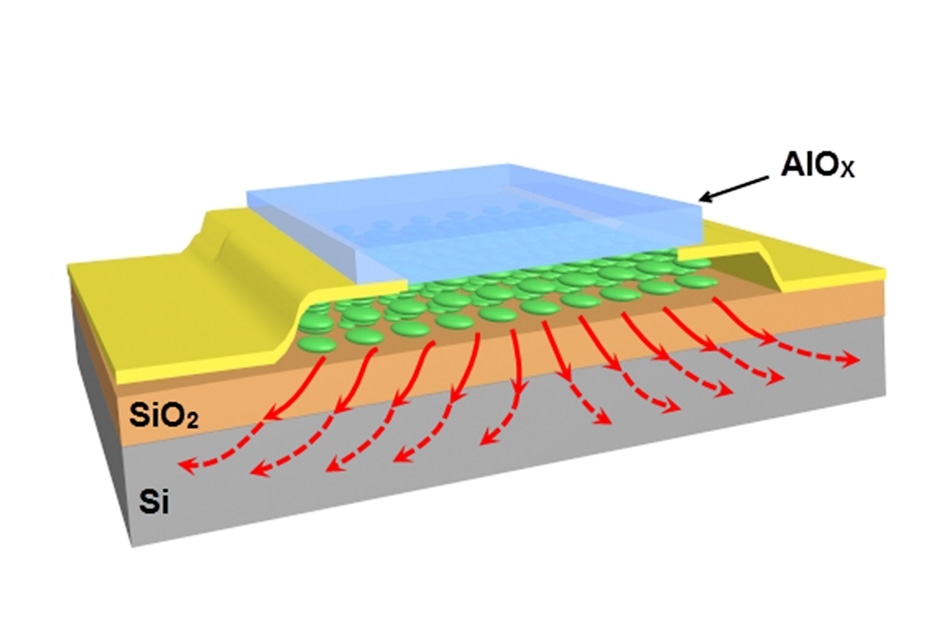Sep 14 2018
Sandwiching two-dimensional (2D) materials used in nanoelectronic devices between their three-dimensional (3D) silicon bases and an ultrathin layer of aluminum oxide can greatly lower the risk of component failure because of overheating, according to a new research reported in the Journal of Advanced Materials led by scientists at the University of Illinois at Chicago College of Engineering.
 An experimental transistor using silicon oxide for the base, carbide for the 2D material and aluminum oxide for the encapsulating material (Image: Zahra Hemmat).
An experimental transistor using silicon oxide for the base, carbide for the 2D material and aluminum oxide for the encapsulating material (Image: Zahra Hemmat).
A number of present-day silicon-based electronic components comprise 2D materials such as graphene. Adding 2D materials like graphene that is made up of a single-atom-thick layer of carbon atoms, into these components allow them to be several orders of magnitude smaller than if they were created using conventional, 3D materials.
Furthermore, 2D materials also enable other exceptional functionalities. But nanoelectronic parts with 2D materials have an Achilles’ heel—they are susceptible to overheating. This is due to poor heat conductance from 2D materials to the silicon base.
In the field of nanoelectronics, the poor heat dissipation of 2D materials has been a bottleneck to fully realizing their potential in enabling the manufacture of ever-smaller electronics while maintaining functionality."
Amin Salehi-Khojin
One of the reasons 2D materials cannot properly transfer heat to silicon is that the interactions between the 2D materials and silicon in components like transistors are quite weak.
“Bonds between the 2D materials and the silicon substrate are not very strong, so when heat builds up in the 2D material, it creates hot spots causing overheat and device failure,” explained Zahra Hemmat, a graduate student in the UIC College of Engineering and co-first author of the paper.
So as to improve the connection between the 2D material and the silicon base in order to enhance heat conductance away from the 2D material into the silicon, engineers have experimented with incorporating an extra ultra-thin layer of material on top of the 2D layer—in effect forming a “nano-sandwich” with the silicon base and ultrathin material as the “bread.”
“By adding another ‘encapsulating’ layer on top of the 2D material, we have been able to double the energy transfer between the 2D material and the silicon base,” Salehi-Khojin said.
Salehi-Khojin and his colleagues developed an experimental transistor using silicon oxide for the base, aluminum oxide for the encapsulating material, and carbide for the 2D material. At room temperature, the scientists observed that the conductance of heat from the carbide to the silicon base was twice as high with the inclusion of the aluminum oxide layer versus without it.
While our transistor is an experimental model, it proves that by adding an additional, encapsulating layer to these 2D nanoelectronics, we can significantly increase heat transfer to the silicon base, which will go a long way towards preserving functionality of these components by reducing the likelihood that they burn out.
Our next steps will include testing out different encapsulating layers to see if we can further improve heat transfer.”
Salehi-Khojin
Poya Yasaei, Zahra Hemmat, Liang Hong, Amirhossein Behranginia, Leily Majidi and Robert Klie from the University of Illinois at Chicago; Cameron Foss and Zlatan Aksamija, from the University of Massachusetts, Amherst, and Shixuan Li and Michel Barsoum from Drexel University are co-authors on the paper.
This study was supported partly by grants EFRI 2-DARE Grant 1542864, DMR-0959470 and DMR-1626065 from the National Science Foundation.